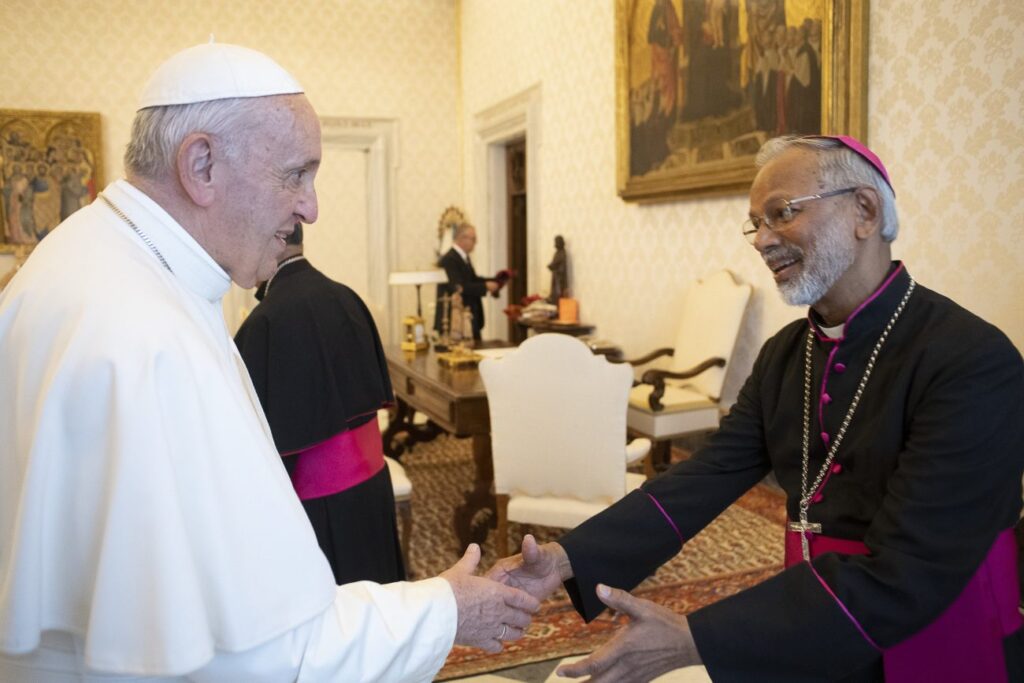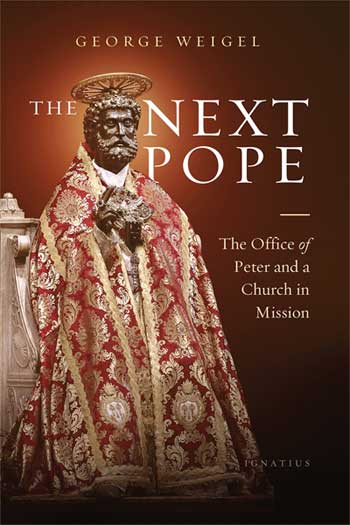The recent death of Pope Francis and the subsequent election of Leo XIV to the papal throne have reignited media interest in the papacy. Beyond the attention given to the personalities of individual Popes, what is the office of the Pope? What are his prerogatives according to the Roman Catholic Church? How does this institution fit into the global world and in the ecumenical relationships outside of Rome?
These questions are all considered in the newly released study document by the Vatican Dicastery for Promoting Christian Unity: “The Bishop of Rome. Primacy and Sinodality in the Ecumenical Dialogues and in the Responses to the Encyclical Ut Unum Sint” (2024; henceforth BoR). The 170 page text surveys the ongoing ecumenical dialogue concerning the role of the Pope and the exercise of the Petrine Ministry. Its remote context is the invitation made by Pope John Paul II exactly thirty years ago. In fact, in his 1995 encyclical “Ut Unum Sint,” the then Pope asked Church leaders and theologians “to find a way of exercising the primacy which, while in no way renouncing what is essential to its mission, is nonetheless open to a new situation” (n. 95).
On the one hand, in John Paul II’s view, the papacy was to be maintained in its essentials; on the other, it was presented as open and willing to rethink itself in fresh and accepted ways. Almost twenty years later, Francis spoke of his desire to see a “pastoral conversion” of the papacy (The Joy of the Gospel, 2013, n. 32) that would make it at the service of the whole of Christianity, indeed the whole world. Among other things, his insistence on referring to himself as “the Bishop of Rome,” rather than with other titles claiming universal authority, was a way to encourage such a process of acceptance.
The document brings together the fruits of the ecumenical dialogues on the ministry of the Pope in response to the invitation by John Paul II. It is not a synthesis of Roman Catholic teaching on the papacy, but rather a summary of the discussion generated by Ut Unun Sint, as expressed in 30 official responses and 50 documents that reference it. Its goal is to seek a form of the exercise of the papacy that is shared by all churches that participate in the ecumenical movement with the Roman Catholic Church, e.g. Eastern Orthodox, Oriental, Anglican, and historic Protestant.
BoR provides a state-of-the-art document where one can find important indications of the evolution of the papacy, with some insights on possible future outlooks. Here are some interesting findings.[1]

Infallibility?
Since its definition, the 1870 Roman Catholic dogma of papal infallibility has been a stumbling block between Rome and the other churches, on both sides of the East-West divide. As it was formulated then, this prerogative of the Pope simply could not be accepted by non-Catholics. However, BR suggests a way forward.
As far as the hermeneutics of Vatican I is concerned, it has become an accepted ecumenical principle to interpret it in the light of Vatican II (nn. 61 and 66) and therefore placing infallibility in the wider context of Vatican II ecclesiology. The latter stressed the collegiality of bishops (the Pope being one of them and never to be considered in isolation from them) and recognized a more active role for the laity in the life of the church. Vatican II’s ecclesiology underlines “communion” and considers the Pope as part of it. The infallibility promulgated at Vatican I should be “re-received” (n. 145), i.e. re-interpreted, against the background of Vatican II.
Then, BoR distinguishes between the text of the dogma of infallibility and its intention. The former may seem overly juridical and authoritarian, but the intention was to protect and serve the indefectibility of the whole Church (n. 70). This is a concern that can be shared by all ecumenical Christians. If Vatican I can be interpreted in this way, even non-Catholics may be prepared “to acknowledge papacy as a legitimate expression of the Petrine ministry of unity” (n. 73).
A Ministry of Unity in A Reunited Church
“Is a primacy for the whole Church necessary?” is the question that opens paragraph 75. Many ecumenical dialogues have recognized the need for it for three reasons.
First, the apostolic tradition. From the 4th century and definitely so from the 7th century, the See of Rome was considered “the first in the hierarchy” (n. 76), although, as already noted in an earlier section, this primacy is due to political reasons and not biblical ones. Rome was the capital of the empire, and the bishop of Rome began to be seen as presiding over the others because of the importance of the city of Rome in the Roman Empire (n. 78).
Second, the ecclesiological argument. For those churches that have an episcopalian form of government (i.e. led by a bishop), it is obvious that what happens at the local level should happen at the universal level. In other words, if a bishop is given authority over a local diocese, it is appropriate that the world as a whole has a bishop ruling over it.
Third, a pragmatic argument. Many churches readily admit “the need for global instruments of communion” (n. 84) that are capable of resolving conflicts between local churches and representing them before the global world. Some dialogues have also argued that the ministry of unity granted by the papal office would also serve a reinvigorated, common mission (n. 86).
Looking back at the history of the development of the papacy, BoR recalls what Joseph Ratzinger wrote in 1982, i.e. “Rome must not require more of the East than was formulated and lived during the first millennium” (n. 91). This is in line with John Paul II’s openness to change without altering the essentials of the papacy. Moreover, in the first millennium, “communion” was lived out in primarily informal ways, rather than being carried out within “clear structures” (n. 93). The authority of the Roman Pope was mainly characterized by a “primacy of honour” (n. 94).
How to overcome the gap between the primacy of honour (ecumenically acceptable by the East) and the primacy of jurisdiction (as it was developed in the second millennium by the Roman Catholic Church) remains an open question (n. 98). The way forward is to see how the “communal” (all,i.e. Christians), collegial (some, i.e. the bishops) and personal (one, i.e. the Pope) dimensions of church life interplay (n. 116) and find ways that are compatible with the different traditions. What BoR bears witness to is the reality that all ecumenical partners are willing to engage the issue constructively.

Three Key Steps for the Ecumenical Future of the Papacy
After surveying the main contents of BoR, it is time to look at the document within the broader context of the present-day ecumenical setting and to try to become acquainted with its theological narrative. According to the fruits of the ecumenical dialogue gathered in the document, the Papacy will have a future as a world-wide, religious institution at the service of the reunited Church. None of the ecumenical partners questions this prospect. It is a matter of how and when, not if and why. Gone are the times when, from both East and West, the Roman Catholic Papacy was seen as a non-biblical, insurmountable stumbling block that needed to be removed. It seems that if one wants to be “ecumenical” today, she needs to come to terms with a slightly modified Papacy in terms of its attitudes and titles, but with no change as far as the theological substance is concerned.
In order to appraise what is at stake, one needs to appreciate the trajectory that the Roman Catholic Church has been able to influence over the last 60 years since the Second Ecumenical Council (1962-1965). Here are three important steps that have given shape to the ecumenical framework behind BoR:
1. “Complementary,” no longer “conflicting”
It was the 1964 Vatican II document on ecumenism that said: “these various theological expressions (e.g. those of the Eastern churches) are to be considered often as mutually complementary rather than conflicting” (Vatican II, Unitatis Redintegratio, 1964, n. 17). The principle of complementarity and compatibility was extended to all doctrinal matters. Ecumenical theology sees all differences as belonging to the same reality that is accessible from various angles and interpreted as mutually enriching rather than mutually exclusive. This has become the premise of present-day ecumenism.
Among other things, this means that the evangelical recovery of the gospel captured in the “Christ alone,” “Scripture alone,” and “Faith alone” of the Protestant Reformation is now seen as an “emphasis” to be integrated in the Roman Catholic whole, rather expressing the Christian faith in opposition to the Roman Catholic flawed account of the gospel. The papacy is no longer seen as an institution at the center of a theological conflict, but as an essential part of the Church, in which complementary views are possible and accepted.
2. From “differentiated consensus” to “differentiated exercise”
In 1999, the Roman Catholic Church and the Lutheran World Federation signed the “Joint Declaration on the Doctrine of Justification” (JDDJ), one of the dividing doctrines in the 16th century. JDDJ claims that the document “encompasses a consensus in the basic truths; the differing explications in particular statements are compatible with it” (JDDJ, n. 14). This approach was later defined as “differentiated consensus”: Catholics and Lutherans can agree on the basics of justification and maintain their respective emphases as compatibile. The “differentiated consensus” was later used to foster ecumenical dialogue that would consider doctrines as made of modular units (some of which people can agree upon while disagreeing on others), instead of treating them as aspects of an integrated whole.
Now, BoR shows that the same approach is extended to the Papacy. It involves a “differentiated exercise of the jurisdiction of the Bishop of Rome” (n. 150), spanning from full jurisdiction (the Roman Catholic Church), to “primacy of honour” (Anglican, Oriental and Orthodox churches), to a global leadership role (historic Protestant churches). Ecumenical partners will have the possibility of accessing a “differentiated exercise” of it, picking the aspects they like and leaving aside those they are less happy with. The Papacy will remain for all, although it may look somewhat different from its Roman-second millennium outlook and perhaps closer to its first millennium shape.
3. Open to change, not renouncing the Roman Catholic “essentials”
Now we can see that the invitation given by John Paul II in 1995 was not out of context; on the contrary, it was a reflection of the ecumenical mindset already affirmed at Vatican II and a further development of it. The rules of the game suggested by John Paul II (i.e. open to minor changes, carrying on the essentials) were accepted and are now considered as the shared consensus of the ecumenical movement.
BoR stands on the shoulders of the post-Vatican II attempts made by Rome to call all Christians to be united, overcoming past divisions, seeing all traditions as complementary, and building this unity on differentiated consensus. The other side of the coin is that Rome will at the same time stick to the “essentials” as they are embedded in its doctrinal system – the Papacy being one of them.
The ecumenical unity envisaged by BoR will have the Roman Pope at the center: in a sense, the Roman Catholic business as usual, now updated and conformed to the ecumenical age. BoR is the latest example of the Catholic absorption of different ideas and former opponents, provided they accept that Rome will not change its foundational theological committments that are outside or against biblical teaching, and will instead further expand its synthesis that goes beyond gospel boundaries. Biblical Christianity is not an appeased sub-section of Roman Catholicism but a gospel alternative to a system that is not grounded on Scripture Alone as its ultimate authority and on Faith Alone as to how salvation is to be received.
[1] Reference to sections of the document will appear in parentheses.







